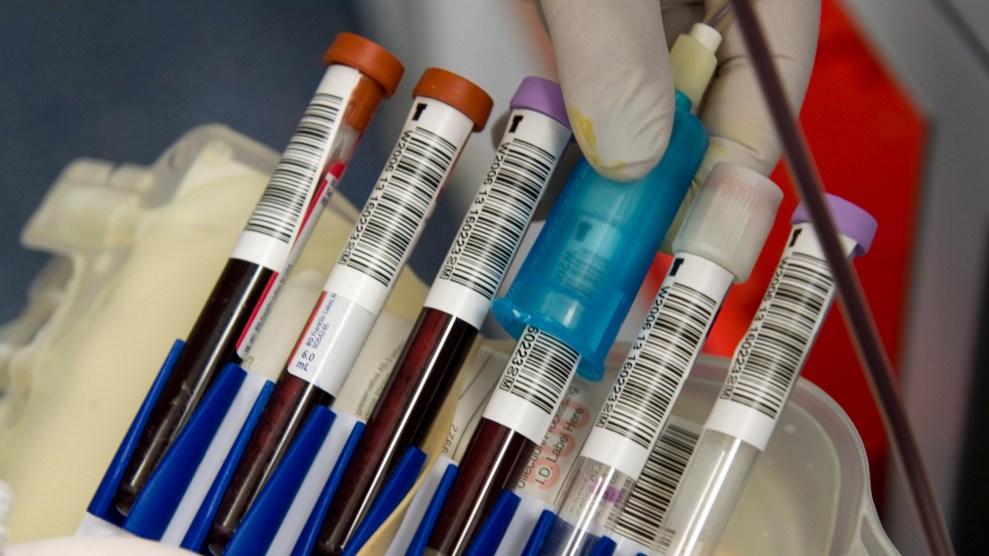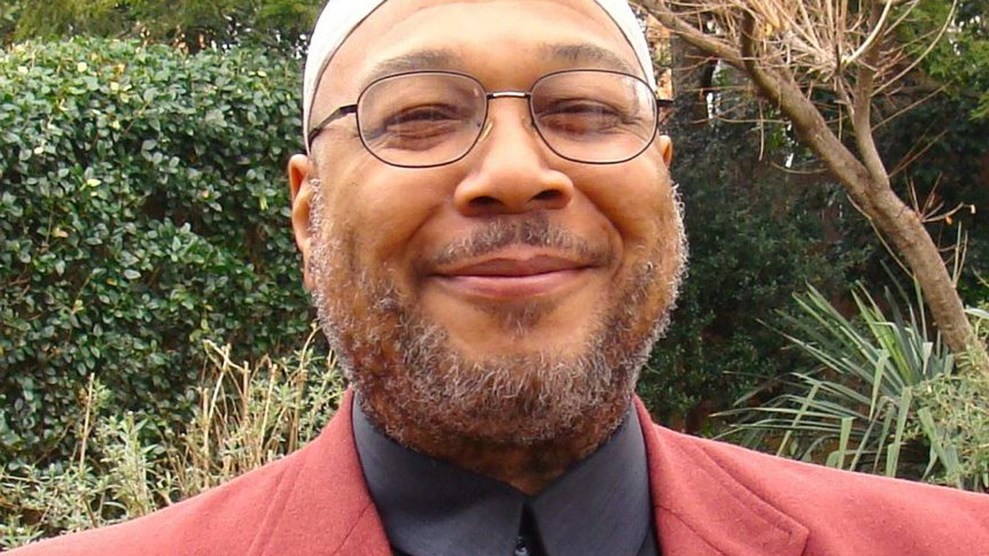
The American Red Cross collects blood during a California blood drive in 2013.Paul Bersebach/ZUMA
By the early afternoon on June 12, hours after a gunman slaughtered 49 people at a gay nightclub in Orlando, hundreds of sympathizers had lined up to donate blood to the 53 young men and women who had survived the shooting. There were many gay men who would have liked to help but couldn’t. Last December, the Food and Drug Administration lifted its lifetime ban on blood donations by men who have sex with men (often referred to as MSM). Gay men could now give blood, the agency announced—but only if they’ve been celibate for a year beforehand. For gay men in America, it is still easier to purchase an assault rifle than to donate blood.
The lifetime ban was implemented during the early 1980s to help stem the spread of AIDS, which doctors had no way to diagnose or treat at the time. Three decades later, HIV/AIDS is a chronic condition, and advances in diagnostics have made it possible to detect infection within as few as nine days of exposure. But medical progress and political progress are asymmetrical. Despite years of criticism from the American Association of Blood Banks, the New York City Council, and the American Medical Association (AMA), the prohibition remained in place. “The lifetime ban on blood donation for men who have sex with men is discriminatory and not based on sound science,” the AMA declared in 2013.
So the FDA finally relented, somewhat, by reducing the lifetime ban to a yearlong moratorium on donations after the last male-to-male sexual encounter. “The 12-month deferral window is supported by the best available scientific evidence,” Dr. Peter Marks, head of the FDA branch that crafted the recommendation, said in a statement announcing the new policy.
Dan Bruner, the senior director of policy at Washington, DC’s premier HIV clinic, Whitman-Walker Health, was disappointed. “The updated policy is still discriminatory and not rooted in the reality of HIV testing today,” he wrote in response. “The deferral period should be no longer than 30 days.”
In the aftermath of Orlando, as a flurry of politicians, mourners, and activists have renewed their call for the FDA to rethink its 12-month policy, old arguments about public health and identity politics have re-emerged. Once again, health authorities, doctors, and LGBTQ advocates are looking at the same studies and clinical data and coming away with opposing conclusions on what constitutes the “best” scientific evidence.
There’s an emotional history here. By the time the FDA released the first reliable HIV test in 1985, more than 14,000 surgery patients and hemophiliacs were known to have been infected by blood transfusions—a veritable death sentence. Thousands of the fatal donations came from closeted gay men. Even with a test available, infected blood still snuck into the blood supply, because there is a window during which the virus is undetectable in the bloodstream of an infected person. The most common HIV test looks for antibodies against the virus rather than the virus itself. Just as there’s a lag between the intrusion of a burglar and the arrival of police, there’s a lag between pathogen and antibody. In the 1980s, the lag period was around a month. Today, every unit of blood collected in America must pass a nucleic acid test, which can detect HIV nine days after a person is infected.
Bruner, who is gay, is frustrated by the disparity between the FDA’s new policy and modern HIV diagnostics. “I’m married and have been in a monogamous relationship for 33 years,” he says. “If the Red Cross had a blood drive and I wanted to give, I could hold off on sex for a month. I could understand that. But the one-year ban is illusory progress. It says, ‘You can’t donate if you have a sex life.'” Bruner compares the current situation to the exclusion of homosexuals from the military for the sake of troop cohesion. “Don’t Ask, Don’t Tell,” a policy enacted in 1994 under President Bill Clinton and eliminated in 2011, allowed homosexuals to serve only if they remained in the closet, putting gay sex at odds with civic duty. “Donating blood is something normal people do,” Bruner says. “The FDA’s policy treats MSM as if they’re not normal, as if they have an infection even when they don’t.”
Indeed, the FDA does not consider MSM normal when it comes to HIV. “A history of male-to-male sexual contact was associated with a 62-fold increased risk for being HIV positive,” Marks tells me. He adds that MSM comprise 2 percent of the population but account for two-thirds of new HIV infections. “If everyone was 100 percent truthful and never cheated, the current nucleic acid test would be able to take care of things,” he explains. “Say you and your partner always use condoms. That also has a failure rate. With anal receptive intercourse it’s 1 to 2 percent.” That adds up fast when your agency is responsible for the safety of millions of Americans.
The FDA relies on data to craft policy, and because American researchers have not thoroughly studied a shorter deferral period for MSM, the agency instead looked to Australia, whose HIV epidemiology and blood screening systems are similar to those in the United States, according to Marks. In 2000, Australia replaced its own indefinite ban on MSM blood donations with a 12-month deferral for sexually active gay men. Australian researchers then studied millions of blood donors from the mid-1990s to the mid-2000s and found no statistically significant increase in the number of HIV-positive donors under the new policy, much less transfusion-borne infections.
Health officials in Italy tried something different: They eliminated MSM deferrals entirely in 2001 and began assessing each donor’s risk with an extensive questionnaire. In 2013, Italian researchers concluded that this individual risk assessment was just as effective at screening out HIV-positive donors (regardless of sexuality) as their nation’s mandatory MSM deferral had been.
Preempting questions about these findings on C-SPAN, Marks said that heterosexuals account for a much larger proportion of new HIV infections in Italy than in the United States. He claimed that getting rid of deferrals and relying only on HIV testing would quadruple the rate of infection through the blood supply. In a subsequent interview, he also said it “wasn’t too big a leap” to make policy based on a six-year-old study of another country’s policy. “We want data we can hang our hat on,” he said.
Public health, of course, is not clinical medicine in aggregate. Doctors treat individuals and can see the result of a prescription in days, but public health officials deal in million-person trends and decade-long studies. It’s therefore not surprising that the FDA’s blood-donation policy lags a decade behind modern diagnostics. “For every letter we got saying we should advance the policy, we got one saying that we shouldn’t change the policy,” Marks says. Imagine the response had the FDA tried to end its MSM ban six years ago, when Australian researchers first published their study. In 2010, a majority of Americans opposed same-sex marriage, including President Barack Obama (publicly, at least). Today, we are more sympathetic to LGBTQ people, but the association of AIDS with gay men endures, in part because the latter still account for a staggering proportion of the US HIV-positive population—more than 40 percent as of 2011.
Dr. Gerald Friedland, an AIDS expert at Yale New Haven Hospital, can sympathize with both sides. “There is logic to [the current policy] because MSM are the highest-risk population, but there is a danger of stigmatizing,” he says. “Every epidemic is a mosaic of smaller epidemics. Risk is contextual.” For instance, African Americans make up 41 percent of the 1.2 million HIV-positive Americans despite being only 12 percent of the population. In 2014, roughly a quarter of the nation’s 45,000 new HIV infections were black MSM. Poverty, access to housing and education, and geography matter, too. The South is home to 37 percent of the population but 44 percent of Americans with HIV. Yet there are no special donor questions or deferrals for black people, poor people, or Southerners.
Friedland says the FDA may have crafted its policy in deference to the hierarchy of medical evidence. “When we make guidelines for antiretroviral therapy, for example,” he says, “a strong recommendation will receive an ‘A’ if it’s based on two double-blind randomized control trials”—experiments in which neither the researchers nor the subjects know who receives the medication and who receives a placebo. A recommendation receives a “B” if it relies on observational studies, which Friedland describes as “lots of evidence but not randomized evidence.” (The studies from Australia and Italy would probably receive a “B.”) The third threshold, a “C,” is based on a consensus of expert opinion in situations where there are no good studies. (The idea of shrinking the MSM deferral to 30 days would get a “C” because it hasn’t been studied.) “Many decisions are made on this basis,” Friedland says. “There might have been a difference of opinion [within the FDA] that led to a less-than-forceful recommendation.” The apparent unwillingness of the medical community to undertake clinically relevant studies of a 30-day deferral for sexually active gay men—research many experts say could be conducted without endangering any transfusion recipients—leaves in place a somewhat arbitrary policy that feels discriminatory to many Americans.
Earlier this spring, I went to a Red Cross blood drive in New Haven, Connecticut, and found that the nonprofit had yet to implement the FDA’s “less-than-forceful” recommendations. Its laminated donor handouts still told gay men they could not donate blood, period. Dr. Dominick Giovanniello, the American Red Cross’ medical director for Connecticut, explains that the policy change is more gradual and complicated than media reports made it seem back in December. The new policy, Giovanniello says, was issued as a “draft guidance” back in May of 2015, which gave blood banks time to absorb the changes and get donation centers up to speed, rewriting and reprinting donor manuals, creating new programming for computer-based questionnaires, and retraining phlebotomy staff.
The American Red Cross, a private entity regulated by the FDA, is responsible for about 40 percent of the nation’s blood supply, more than 5 million pints every year, and it wants its policies and facilities to be “in sync” nationwide before it rolls out the changes. Donation facilities less strict than the FDA recommends can be cited or even shut down, so they err on the side of strictness. Yet more than a year has passed since the FDA issued the draft guidance, and the American Red Cross has yet to end the indefinite deferrals. “I’m a little surprised that it’s taken blood banks this much time,” Marks told me.
The ongoing deferral puzzles many LGBTQ advocates, given how vital blood is to the health care system. The Williams Institute, a think tank affiliated with the UCLA School of Law, found that the 12-month deferral forfeits as many as 300,000 pints of blood every year. Ending it, the institute wrote, could “help save the lives of more than a million people.”
Then again, the nation’s demand for blood is down significantly, falling by 27 percent from 2008 to 2013, due to the emergence of minimally invasive surgery and evidence that high-volume blood transfusion is risky and expensive. But the complex biology of blood means that even a slight expansion of the donor pool could save many lives. Although more than two-thirds of Americans have A-positive or O-positive blood, around 9 percent have O-negative and 3 percent have AB-positive, and these rarer types are highly versatile: You can transfuse any patient with O-negative blood cells, and AB plasma is accepted by any body. “There’s always a need for AB plasma and O-negative red blood cells,” Giovanniello says. Having these rare types on hand is especially important when time is short—say, in the aftermath of a mass shooting.
When I ask Marks about the Orlando attack and whether the FDA plans to respond to the renewed criticism of the 12-month deferral, he replies that the agency is “on a course to gather more data to move the policy forward” and that a new plan has “been in the works for weeks and weeks.” He and his staff would only hint about what such a plan might entail. Lorrie McNeill, Marks’ communications director, tells me that many in the LGBTQ community feel that any time-based deferral would be discriminatory. “The comments we heard back were overwhelmingly in favor of moving toward an individual risk assessment,” McNeil says.
Marks has previously said that the FDA hopes to better understand why HIV-positive people would donate blood, which requires thinking about how and why people lie when answering donor questionnaires. “Most donors answer questions as if they’re asking ‘Is my blood safe?’ rather than what they actually ask,” he tells me. “If people feel like we have a fair policy, then they’ll be more likely to comply. There are certain questions that make people so embarrassed that they won’t answer truthfully.”
Marks is cagey about what an improved donor questionnaire might include. “If I could ask you your favorite kind of ice cream bar, and that would predict with 99.9 percent accuracy that you were safe to donate,” he says, “then that would work.” In any case, an FDA study on the effectiveness of a less invasive, more holistic donor history questionnaire would show that the agency is seeking evidence that could support an effective individual risk assessment.
But even if the FDA takes this step, the research would take years to complete, could be cut short by a Republican administration, and might deliver inconclusive results. In the meantime, queer men who want to give blood have to re-enter the closet for an afternoon. The FDA has thought through its policies with care, but its circumspection is lost on millions of gay men and their allies who view the deferral as a symptom of the same phobia that apparently brought a man with an assault rifle to a gay club. The current policy suggests that the federal government is more concerned with preventing injury than insult. With better evidence, it won’t have to choose one or the other.















